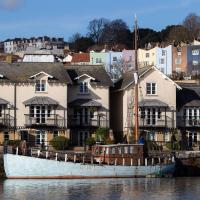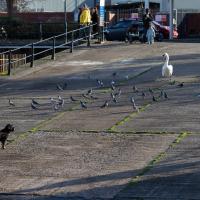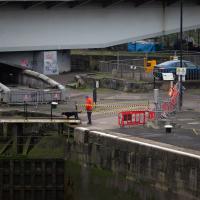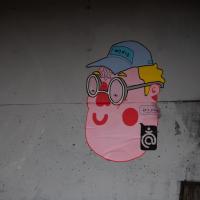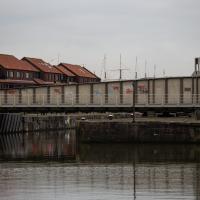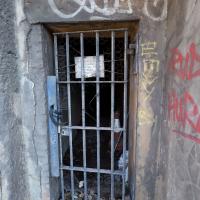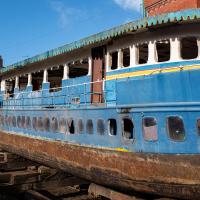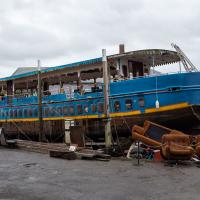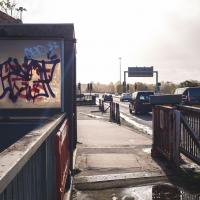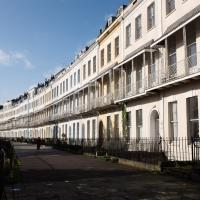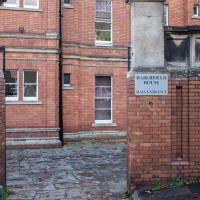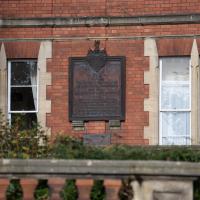Tagged: uk
Quick Coffee
19 Nov 2020
A sunny day, and though I should have probably headed for less well-travelled territory I just headed over to the Marina to grab a flat white from Imagine That's horsebox café.
I'm not entirely sure why this little pole seems to need so many red lights, or what the tiny circular thing that looks like a specialist antenna is at the top (there's clearly a few other antennas, and I also have no idea what they're for.) Just part of the varied harbour infrastructure I walk past every day and would probably be fascinated to hear about if I knew who to ask...
What, should I keep clear from this side? I'm assuming that this doesn't actually affect anything on dry land...
Nothing New
02 Dec 2020
This may be the very first time I've gone for a One Mile Matt wander and not actually gone down any new roads, trod any new steps. I just wanted a coffee, frankly, so I went the same old way to Imagine That in the marina and back again.
I think someone lost their hair extension. Or this is the resting place of a My Little Pony that's been buried arse-up.
I'm always a little worried that one day a swan's going to get garotted by this wire strung across the bit of Cumberland Basin behind the little causeway. It's used by the water football (?) people to string their goal up.
The more I research it, the more I find that Hotwells had far better transport links back in Victorian and Edwardian times than it has today. Along with buses that went to more useful places than the City Centre, there were trams, the funicular up to Clifton, the landing stage for paddle steamer services and two railway stations all within easy walking distance of me.
Today I took a day off work as preparation for doing the bookkeeping for my tax return1, and took a wander along to the site of what would have been my nearest station, Hotwells (or Clifton, as it started out in life), nestled in the shadow of the suspension bridge, the Bristol terminus of the Bristol Port Railway and Pier.
From there I wandered down the Portway, following the original line, until I got to the area around Sneyd Park Junction, where the tunnel from the slightly later Clifton Extension Railway joined up with this originally-isolated BPR line. Then I headed up to Clifton through the "goat gully" at Walcombe Slade, seeing the few above-ground bits of evidence of the tunnel (which is still in regular use) along the way.
It was a lovely day, and a good walk, and it was interesting to daydream of the times when I could have walked a few minutes from my flat down to Dowry Parade, caught a short tram ride to Hotwells Stations, and then headed from there to Avonmouth, perhaps even to board a transatlantic passenger service. The completion of the Clifton Extension Railway that linked the Avonmouth station with Temple Meads made relatively direct transatlantic travel from London via Bristol possible, with passengers travelling up from Paddington to Temple Meads, on to Avonmouth on the Clifton Extension Railway and Port Railway and Pier line, then perhaps catching a Cambpell's paddle steamer—which sometimes acted as tenders for large steamers—to a larger ship that was headed out for Canada, say.
1 I've learned that the best approach is to take two days off and deliberately do something that's not my bookkeeping on the first day, as otherwise I just inevitably end up procrastinating and feeling guilty on the first day no matter what. I have an odd brain, but at least I'm learning strategies for dealing with its strange ways as I get older...
2 Information mostly gleaned from Colin Maggs' The Bristol Port Railway & Pier and the Clifton Extension Railway, The Oakwood Press, 1975.
I did not see hide nor hair of a single goat the entire time I was in the goat gully. I clearly need to spend a bit more time there.
I'm pretty sure from looking at some maps that this is the gate that would have led to Prince's Lane, if it were still passable.
St Vincent's Parade looking a bit more run-down than normal. This street, like the one I live in, was built as lodging houses for visitors to the hot wells. I imagine it was quite a pleasant aspect before later developments like the building of the Portway.
I didn't go inside, just shot through the gate with a steady hand. I have been in there, though, on one of the open day tours.
From The Bristol Hotwell, by Vincent Waite, ISSN 1362 7759, Bristol Branch of the Historical Association, 2002 reprint.
...in 1867 the new Pump Room was in turn demolished so that Hotwell Point could be removed and river navigation made safer. Thus the spring was lost after a long and eventful history. After much public agitation and complaining in the local press the spring was enclosed and piped to a small grotto hollowed out in the rock. Here a pump was set up in 1877 and an attendant provided by the Bristol Docks committee. In 1880 Dr. Griffin wrote a warning letter to the newspapers claiming that his analysis of this pump water proved that it was not from the original spring which in any case was too far away to retain its correct temperature. Yet up to 1913 the pump was still in use, and sometimes supplied as many as 350 persons a day. Then the long-threatened pollution of the water by the river became too obvious to be ignored and the pump was closed. The entrance, blocked up by a small wooden door, can still be seen in Hotwells Road near the Suspension Bridge.
The wooden door is no longer here, but this is definitely the place.
One of the many problems with the Hotwell Road and Portway is the complete dearth of places to safely cross this road, with a varying number of lanes and a speed limit that hits 50mph for stretches.
You can stand for a very long time looking both ways before taking your life into your hands and scurrying across. It took me quite some time to dash to the other pavement at the point where this one runs out and your only choice is to head up the Zig Zag or cross.
Mokoko
26 Oct 2020
A dash around the harbourside to see if I can get to Mokoko and back in my lunch hour.
This was my first wander and I was still getting the hang of the technology. I managed to record only part of the way back on my GPS, by the looks of it, so I've had to bodge things a bit to pick up the photos, which is why there are photos in places the track doesn't reach!
I also need to fix a few technical things including managing my photo timezones more carefully. This wander was the day after the clocks went back for winter, and I think my camera may still have been in BST, which may not have helped me tie things up. Need to do a bit of research into how my cameras, Lightroom and the code I'm writing on this website handle BST and GMT, but at least I have until the last Sunday in March before things get urgent, I think...
I'm not sure about publishing this one. I wouldn't normally snap a photo of a single stranger in an only-semi-public place like a cafe. On the other hand, I thought it was an interesting document of the way people are coping with Covid and I quite like it as photo, which tipped the balance into publication.
Mokoko's almond croissant are one of my favourite treats in Bristol. I'm glad they're pretty much diametrically opposite me on the harbourside—if they were easy to get to I'd be a lot fatter.
The End of a Private Road
27 Oct 2020
One of the homes in Windsor Terrace went on the market for £2,000,000 a few years back. This is the closest I've been to it, right at the end of the private road. Presumably they're okay with people wandering down the road if there's a blue plaque to be seen at the far end?
Both the plaque to Edward St John Daniel and the other photo I took (in these early walks I was mostly walking, rather than mostly taking photographs) have interesting stories of a rise and fall associated with them in the first Google hits I found. Daniel was indeed the youngest recipient of the VC, but was stripped of the medal by Queen Victoria herself in 1861, following conviction for desertion and evading court martial. Lubetkin is probably most famous for designing the penguin pool at London Zoo, which was closed 17 years ago, after the micro-abrasions in the penguins' feet caused by the concrete led to them developing an infection with the charming name "bumblefoot".
Designer of, among other things, the London Zoo penguin pool, and Highpoint, described by Corbusier as "This beautiful building .... at Highgate is an achievement of the first rank", and I like Corbusier's ideas, having read about them in How to Make a Home, I think, so that was what caught my eye on the Wikipedia page.
Greville Smyth
28 Oct 2020
Popped out for a coffee in Greville Smyth park, and got a view of the Andy Council work on the side of the Ashton Avenue sewage pumping station on the way back.
Catherine Progress
29 Oct 2020
They're refurbishing (by which they seem to mean ripping almost completely apart and rebuilding) the Catherine in Underfall Yard at the moment. I like checking on the progress when I pass by the Patent Slip.
I nearly threw this shot away, but the weird look of the photo sort of goes okay with the weird look of passionflowers in general. Alien-looking thingies. This one's in a front garden at the Cumberland Road end of Avon Crescent.
Most of the refit of the Catherine so far seems to have involved throwing increasingly large chunks of it away. I thought those chairs looked really comfy, though, apart from the fact they'd have been sopping wet from the rain. And who knows what else, given the Catherine's rather chequered past—apparently it was a brothel for a while, among other things.
They've been trying to pretty it up, but it's a bit like putting a small elastoplast on a severed limb.
Bedminster
31 Oct 2020
Starting up close in Hotwells with a few bits around the Cumberland Basin flyover system, I walked to Bedminster and back on Hallowe'en, including finding some excellent decoration work.
Not many people want to get from one side to the other here, and those that do normally just cross the road; it's normally fairly quiet.
I may have used these steps, a few hundred metres from my house, at some point since I moved in, 21 years ago, but I don't remember doing it.
I like the way I can sometimes make something that seems pretty out of the less-attractive bits of the Cumberland Road Flyover System
Not sure I've walked along the flyover here. Have I ever seen the Cumberland Basin from this angle before?
Royal York Crescent
02 Nov 2020
I've taken a lot of photos of Royal York Crescent over the years. This time I walked right to the dead-end bit at the far west corner and found a plaque to the Empress of the French. Call me hard to impress, but among the scientists, novelists, architects and artists whose plaques litter the rest of the area, that seems quite minor claim to fame.
A gated community, apparently. There's a few of these little enclaves in Clifton, often hidden "around the back", as mews always were, I suppose.
I enjoy walking along Royal York Crescent enough that it's a frequent diversion from my quickest way home
And in between times were the Napoleonic Wars, which probably explains the desire for a barracks.
I've been tempted to try these Voi scooters-for-hire to expand my range for lunchtime wanders. However, having read their rules, at 118kg I'm 18kg over their maximum weight limit.
Local
03 Nov 2020
A very local exploration today, but there are still bits of the near field that I never need to walk down, so it didn't take me long to find somewhere I haven't been in a decade or more, the little enclave of smaller Victorian houses around Oldfield Road and Sandford Road. I'd really like to live in one of those houses, but I doubt I could afford it.
Another place I've passed so many times that I forget it's there. Haberfield House is a giant Victorian almshouse on Joy Hill, hidden from the Hotwell Road by a tall brick wall, but apparently with gardens around that side. I believe it's now privately-owned bedsit-style accommodation, but it's hard to find out much about it. It doesn't help that there's at least one other Haberfield house in Bristol (also an ex-almshouse, now and old people's home) which makes searches a little difficult.
There are ongoing proposals from the owner to convert the roofpace into more flats, in Bristol's ongoing mission to cram even more poeple into even less space, it seems.
This Charity was
FOUNDED BY
Dame Sarah Haberfield
In Affectionate Remembrance
OF HER HUSBAND,
Sir Jobn
Kerle Fabertied
KNIGHT
SIX TIMES MAYOR OF BRISTOL,
Who Died on the 27th December, 1857
HAVING BEEN
FOR MANY YEARS AN INHABITANT OF THE
PARISH OF ST. MARY REDCHEFE AND
OF THE PARISH OF CLIFTON
The Rose of Denmark, there, trying their best to ply some kind of trade during the lockdown.
I imagine it got more use when the GP surgery down the road was still open. Dr. Ring retired a few years ago, and couldn't find anyone to take it over, more's the pity.





